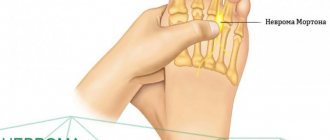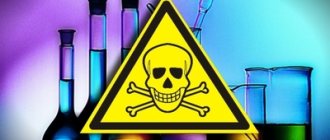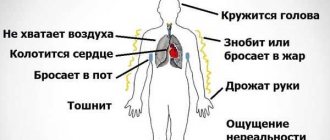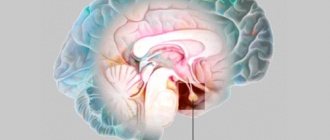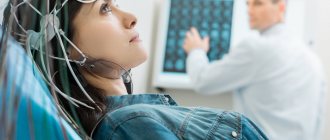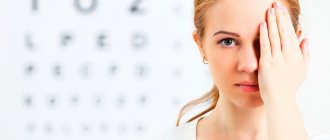How do we see? Images of the surrounding world fall on the retina and are transmitted along the optic nerve to the brain. There the information received is processed and a picture is formed. When the optic nerve is damaged due to insufficient blood circulation, optical ischemic neuropathy begins. This is a serious disease that causes temporary or permanent vision impairment, including blindness.
Specifics and classification of the disease
Neuropathy, nerve damage, can be divided into several types .
The problem is classified in most cases depending on the factor that led to it.
Diabetic
Most often, the nerves of the lower extremities suffer due to the high wear and tear of small vessels. A person suffering from it may notice problems in the thigh, lower leg, and even in the genital area. Damage to the sciatic nerve occurs in 67% of cases.
Toxic
Intoxication, including due to the spread of infections, leads to disruption of the functioning of blood vessels, and nerve fibers suffer. Any nerve can be affected here, be it the facial nerves (neuropathy of the facial nerve, trigeminal nerve, etc.) or the nerves of the limbs.
Since large nerves also have branches that are also affected by the problem, the affected area can be extensive. This is the so-called muscular-tonic syndrome, a pathology associated with degenerative changes in the spine. Due to compression of the nerve in the area of one of the vertebrae, the entire innervated area will suffer.
For example, when the psoas major muscle spasms, it affects not only nearby nerves, but also the sciatic nerve, as well as nerve fibers down to the feet.
Post-traumatic
The cause of this neuropathy is trauma. Depending on which area of the body is affected, one or another nerve will suffer. Neuropathy of the ulnar and radial nerves is especially common.
Mixed
The so-called mixed form of neuropathy requires more attention. It is divided into two types: tunnel and compression-ischemic. We are talking about those cases when compression of the nerve for any reason occurs in certain anatomical areas - tunnels. Their second name is “vagina” - these are those natural cavities that are formed by bone, tendon and muscle tissue. With various problems (swelling, fracture or neoplasm), a narrowing of these channels occurs.
Compressive ischemic neuropathy (or neuropathy) is a problem associated with damage to the neurovascular formation. Due to pinching or squeezing, which can occur for a number of reasons, compression of a certain area occurs, and subsequently (sometimes immediately), its ischemia (slowing of blood supply). As a result, the nerve fibers or their myelin sheath are damaged.
Minor damage to the integrity of the fibers or the development of inflammatory processes in them are possible.
The disease may affect one nerve (mononeuropathy) or most of the peripheral or cranial nerves. In the event that diffuse, often symmetrical, nerve damage occurs, they speak of polyneuropathy.
Since both of these types are similar, some medical publications do not separate them and simply talk about tunnel or compression-ischemic neuropathy.
Causes of neuropathy
Today, medical practice identifies many reasons that lead to dystrophic changes.
m nerves. Among the most commonly diagnosed causes are:
- Intoxication
Poisoning of the body occurs due to exposure to heavy metals, carbon monoxide, mercury, acetone, arsenic, as well as some medications. In addition, toxic damage to peripheral nerves occurs as a result of long-term consumption of alcoholic beverages, especially in chronic alcoholism.
- Diabetes
complication that occurs in people with diabetes . The most advanced forms of this disease lead to the development of diabetic foot, which affects the tissues, skin, and bones of the extremities, leading to their death and, in some cases, to amputation of the foot.
- Injuries
Injuries received during accidents, incidents, or sports provoke the occurrence of neuropathy of the lower extremities. In addition, the disease is accompanied by such causes as hypothermia, radiation or muscle strain due to physical exercise.
- Vitamin deficiency
Insufficient consumption of minerals and vitamins by the body contributes to dystrophic changes. Neuropathy especially develops against the background of vitamin B deficiency, as well as with impaired metabolism.
- Infectious diseases
The cause of the disease can be viral infections, especially during the seasonal period of ARVI, which turn into chronic conditions. HIV is also a common cause.
- Endocrine diseases
Diseases of the thyroid and pancreas, as well as previous operations, can contribute to the development of neuropathy.
- Multiple sclerosis
Multiple sclerosis, as well as other diseases in which the nerve sheath that performs a protective function is destroyed, is one of the common causes of neuropathy in older people.
Carpal tunnel syndrome
This pathology, otherwise known as compression-ischemic neuropathy of the median nerve in its distal part, is associated with compression in the area of three bones and a ligament. Here the tendons of the muscles belonging to the flexors of the fingers and the hand itself are retained.
Pathology is more common in women.
Risk factors include age after 40 years.
Why does the syndrome appear?
The common cause of this syndrome is chronic overstrain of the hand .
During certain work, for example, when weeding beds for a long time or typing on a computer, the muscles become overstrained, they spasm, and the median nerve is subjected to severe compression. In this case, the working hand is first damaged. Also, certain diseases can lead to the development of carpal tunnel syndrome:
- injuries of the wrist, hand;
- degenerative joint pathologies;
- inflammatory lesions of tendons, ligaments;
- metabolic disease;
- tumors, neoplasms.
In case of general diseases, for example, endocrine diseases or metabolic disorders, damage occurs to the nerves of both limbs.
If one arm is injured, only one nerve will be affected.
Acromegaly, a pathology associated with excessive growth of the limbs and parts of the face, and at the same time compression of muscle and nerve fibers, is often identified as the cause of compressive neuropathy.
Symptoms
Carpal tunnel syndrome begins to develop gradually . First, a person feels numbness or tingling in the fingertips, then in the entire hand. Keeping your hand in a certain state becomes more difficult every day.
Increasing pain is also first noticeable in the fingertips, and then spreads throughout the hand. Echoes of pain can be seen in the elbow and even forearm.
Unpleasant symptoms worsen with movement.
If you do not take measures to eliminate the ailments, sensitivity in the hand is lost, and a violation of its function will not be long in coming.
Treatment for ischemic neuropathy
Treatment must begin in the first hours after the onset of symptoms; the need is due to the fact that prolonged circulatory disorders lead to loss of nerve cells.
First aid involves administering aminophylline injections, inhaling ammonia, taking nitroglycerin tablets, further treatment is carried out in a hospital setting.
The goal of therapy is to reduce swelling, provide an alternative route of blood circulation, and improve the trophism of nervous tissue. It is also necessary to take measures to treat the underlying disease, to ensure the normalization of fat metabolism, blood clotting, and blood pressure.
Medications indicated for ischemic neuropathy:
- Vasodilators (trental, cerebrolysin, cavinton);
- Decongestants (diacarb, lasix);
- Blood thinners (phenyline, heparin);
- Vitamin complexes;
- Glucocorticosteroids.
Treatment also involves the use of physiotherapeutic methods (microcurrents, magnetic therapy, laser nerve stimulation, electrical stimulation).
There is no effective treatment for hereditary neuropathies; drugs are ineffective in this case; it is recommended to abstain from alcoholic beverages and smoking. In the presence of neuralgic and cardiac abnormalities, patients are recommended to be referred to appropriate specialists.
With ischemic optic neuropathy, the prognosis is unfavorable; even if all the doctor’s instructions are followed, vision deteriorates, certain areas disappear from view, which leads to atrophy of the fibers of the nerve tissue. In 50% of cases, due to intensive treatment, vision can be improved; when both eyes are involved in the process, complete blindness often develops.
Pronator teres syndrome
It has another name - Seyfarth syndrome , or compression-ischemic neuropathy of the median nerve in the proximal part of the forearm. That is, damage to the same median nerve, but in a different area. In this case, the lesion occurs in the upper third of the forearm. The median nerve here passes through the fibromuscular canal formed by two bones - the radius and the humerus. The pronator teres muscle is also damaged.
Article on the topic: Description and instructions for Depiofen
Causes
A common cause of pronator teres syndrome is physical activity in this area . For example, a dentist or car mechanic who keeps their hands in constant tension and movement suffers from this syndrome in 20% of cases. In most cases, pathology occurs in athletes.
In addition, risk factors include disorders of the elbow joint due to injury or due to the development of arthritis and arthrosis.
Inflammatory processes in the synovial bursae of a joint or muscle and tendon tissue also serve as the basis for the development of the disease.
How to find out the problem?
First, a person notices a previously unusual pronation of the hand. Subsequently, he is unable to tightly clench his hand into a fist, spread his thumbs to the side, or bend them.
The pain is distributed mainly in the shoulder, since there is compression at the level of this particular area.
Radiculopathy: causes, signs, treatment
Radiculopathy is damage or irritation to a nerve root (a collection of nerve cells in the back where they enter or leave the spinal cord).
In addition to pain, radiculopathy can also cause feelings of loss and paralysis. Triggers are often herniated discs. Other possible causes include changes in the bony spine and inflammation.
Read all about radiculopathy, how to diagnose and treat it!
brief information
- Description: Nerve root damage or irritation with pain, paralysis, emotional loss
- Causes: usually pressure on a nerve root or inflammation, in particular herniated discs, changes in the bony spine, arthritis, spondylolisthesis, tumors, hemorrhages
- When to see a doctor? for long-term back pain, especially with radiation pain, numbness and/or paralysis
- Diagnosis: conversation with the patient, physical examination (eg, strength, sensation and reflexes test), if necessary, computed tomography, magnetic resonance imaging, x-ray, electromyography (EMG)
- Therapy: depending on the cause and severity of the discomfort, medications (eg, analgesics, muscle relaxants, possibly cortisone or antibiotics), physical therapy, massage, physical heat treatment, rarely surgery
- Self-help: Exercise your back muscles, pay attention to the correct back posture in daily life (such as correct lifting, correct posture, etc.)
Radiculopathy: description
Radiculopathy is commonly referred to in medicine as a cause of nerve root damage or irritation . If multiple nerve roots are affected, it is called polyradiculopathy .
Radiculitis itself is an inflammation of the nerve root. The term is often used as a synonym for radiculopathy. Other alternative names include neuritis or root syndrome.
What is a nerve root?
Nerve roots are nerve fibers that enter or exit the spinal cord. One distinguishes between the anterior and posterior roots, which still connect in the spinal canal to the spinal nerve.
The spinal nerves, in turn, exit the spinal canal in pairs on the right and left between the vertebral bodies.
Humans typically have 31 pairs of spinal nerves, corresponding to 31 on each side of the body.
Depending on the area of the body and brain, signals are exchanged; this occurs at different heights of the spinal cord. The nerve roots in the cervical spine are responsible for the arms and nerve roots in the lower part of the spinal cord, which ends in adults at approximately the height of the upper lumbar vertebrae.
Each anterior root supplies certain muscles with nerve signals, and each posterior root receives nerve stimuli from certain parts of the organ or skin. Therefore, when a nerve root is damaged, its symptoms correspond to its height. For example, it is usually quite easy to assess the level of radiculopathy based on symptoms.
What are the forms of radiculopathy?
Radiculopathies can be classified depending on the height of the spinal cord. If the nerve roots in the cervical spine are affected, they speak of cervical radiculopathy , in the case of complaints about the lower nerve roots, lumbar or sacral radiculopathy.
The lumbar and sacral regions are more often affected by radiculopathy than the cervical spinal cord. Root syndrome at the level of the thoracic spine (thoracic radiculopathy) is also possible, but relatively rare.
Considering the duration of radiculopathy, acute and chronic forms can be distinguished. Chronic radiculopathy is when symptoms (especially pain) persist for more than 12 weeks.
What are the symptoms of radiculopathy?
Radiculopathy very often results in pain and/or discomfort, such as tingling near the nerve root itself and in the area that supplies them. For example, leg pain is typical of lumbar radiculopathy. Cervical radiculopathies often radiate discomfort in the shoulders and arms.
In addition to pain, numbness of the skin often accompanies radiculopathy. Paralysis (paresis) and decreased reflexes to the associated muscles may also occur.
With radiculopathy, complete paralysis usually does not occur because each muscle receives impulses from several nerve roots.
At the level of the affected nerve root, the back muscles next to the spine are often strengthened (Hartspann). Additionally, the pain increases when the patient clenches, such as when coughing, sneezing, or defecating. Also, when tapping the spine in the corresponding place, it is painful. With radiculopathy of the cervix, patients sometimes experience its expansion.
Who is affected by radiculopathy?
Depending on the trigger, radiculopathy can occur at different ages. However, because many of the possible triggers only develop with age, young people rarely suffer from radiculopathy, and children almost never do.
The most common cause of root syndrome is a herniated disc in the lumbar spine. This occurs most often between the 30th and 50th years of life. After this, the risk decreases again. Herniated discs in the cervical spine are much less common, but occur mainly in younger people.
Radiculopathy: causes and possible diseases
Most causes of radiculopathy can be classified into two main groups: either it creates some form of mechanical pressure on the nerve root, or inflammation leads to symptoms.
Mechanical causes are the most common. These include:
- Herniated disc
- Bone changes in the spine, such as narrowing of the spinal canal or nerve exit site
- Osteoarthritis of the vertebral joints (spondyloarthrosis, osteoarthritis of the facet joint)
- Spondylolisthesis
- Swelling or bleeding
In the case of mechanical damage to the nerve root, inflammatory processes that cause additional irritation often begin over time.
Triggers for inflammatory radiculopathy are usually pathogens such as viruses or bacteria. These include, in particular, the herpes zoster virus (the causative agent of chickenpox and shingles) and special borrelia (the causative agent of Lyme disease).
Inflammation of the vertebral bodies and intervertebral discs (spondylodiscitis) can also spread to the nerve roots. It is often caused by the staphylococcus bacterium. One possible trigger for non-infectious nerve root inflammation is Guillain-Barré syndrome, an inflammatory disease of the nerves due to an abnormal response of the immune system.
Finally, there are also certain diseases that directly destroy nerve root tissue without causing inflammation. An example of this is radiculopathy due to diabetes mellitus (diabetic radiculopathy).
Pseudoradicular syndromes
The symptoms of some diseases can be very similar to radiculopathy, although the nerve roots are not affected.
Most are orthopedic conditions, such as osteoarthritis of the hip or vertebral fractures caused by osteoporosis (bone loss).
If there are symptoms similar to actual radiculopathy, these are called pseudoradicular syndromes.
Radiculopathy: when should you see a doctor?
Back pain is very common, especially as we age, and is often the result of wear and tear on the spine. However, you should always consult a doctor for prolonged back pain to find out the cause.
Especially when the pain spreads and may be accompanied by abnormal sensations, numbness or paralysis, an acute process may occur that requires immediate treatment.
High speed is required when certain warning signs appear. These so-called “red flags” include:
- new or worsening signs of paralysis
- reduction of pain with simultaneous paralysis
- increased pain at night
- previous trauma such as a fall or accident. In older people, even harmless falls can cause vertebral fractures.
These symptoms indicate a medical emergency! Call an ambulance!
Radiculopathy: what does the doctor do?
First, the doctor, in a conversation with the patient, brings up his medical history . In addition, it can accurately describe the nature, location and intensity of pain and other complaints. It also asks about any pre-existing or underlying medical conditions (shingles, herniated discs, diabetes, etc.) and previous injuries/accidents.
Then perform a medical examination. These include, in particular, strength tests, sensitivity tests and reflex tests. If necessary, the following investigation methods are used:
For example, the doctor may request an x-ray of the spine.
Sometimes a computed tomography (CT) scan or magnetic resonance imaging (MRI) scan is performed—but usually only when the above-mentioned red flag symptoms occur.
Another method used to study nerve damage is electromyography (EMG), which measures the natural electrical activity of muscles using needle or stick electrodes.
Radiculopathy: therapy
When treating radiculopathy, pain relief is the first priority. There are several medications available, and the doctor will begin with the administration of weaker painkillers such as paracetamol or ibuprofen (non-opioid or non-steroidal analgesics).
If these drugs are not enough, weak opioid analgesics such as tramadol or tilidine can be added. So-called muscle relaxants eliminate any muscle tension that is often associated with radiculopathy.
In some cases, other medications are needed, such as cortisone medications or antibiotics (for bacterial infections, as a trigger for radiculopathy).
In addition to drug radiculopathic therapy, there are some special treatments that can be used either additionally or alternatively.
With the help of physiotherapeutic exercises, the patient can, for example, prevent incorrect positioning and increase mobility.
Massage can help solve problems with muscle hardening, as well as physical thermal procedures.
Contrary to what many patients believe, bed rest should be avoided if possible. In fact, it is usually beneficial to the healing process if the patient moves early and regularly. At least four days after the onset of complaints, bed rest should be completely abandoned. This requires early pain relief (painkillers, massage, etc.).
In many cases, other than symptomatic relief, no further treatment is required. Symptoms often disappear after a few days or weeks.
If the cause of radiculopathy is mechanical and the patient experiences one or more Red Flag symptoms, it is usually necessary to act quickly to prevent permanent neurological damage.
It is also necessary to prevent the patient from developing chronic radiculopathy (chronicity of symptoms). Because psychological factors such as the expectation of pain also play a role in this regard, it is important for you as a patient to have a good understanding of your disease and treatment options. Ignorance often causes anxiety, and negative expectations increase the risk of chronic symptoms.
Strother's tape syndrome
The syndrome concerns the median nerve in the lower third of the shoulder. Here there is a dysfunction of the pronator, the supra-elbow area of the arm suffers.
Why does it appear?
Experts cite the same reasons for the appearance of Strather's band syndrome as in the case of pronator teres syndrome. The only difference is in the localization of pathological processes.
Here it is the elbow joint that will be affected.
Signs of damage
A person has difficulty bending the first three fingers of the hand and cannot grasp something without effort.
The numbness is abruptly replaced by a burning pain in the area of almost the entire arm. But the sensitivity of the palm remains.
Compression-ischemic neuropathy of the ulnar nerve
Ulnar nerve lesions are divided into three types , based on the portion of the nerve branch.
There are compression-ischemic neuropathy of the ulnar nerve:
- Distal region, ulnar carpal syndrome. The ulnarus nerve, which runs along the outside of the shoulder and passes to the posterior medial, is also damaged.
- Medial region, cubital tunnel syndrome. Here the cubital canal, which carries the nerve through the back of the elbow, is damaged.
The ulnar nerve innervates, in addition to the area of the hand itself, the last 3 fingers on the outer and inner sides of the palm.
Why does the disease appear?
Those who like to lean on their elbows while watching TV or reading a book should know: they are susceptible to compressive neuropathy of the ulnar nerve.
Bruises, fractures and other injuries to the forearm and the elbow joint itself also lead to problems .
We should not forget about the pathologies of the inflammatory, degenerative nature of the joint and its components.
How not to miss the body's signals?
The disease begins with numbness and tingling of the little and ring fingers. There is a lack of sensitivity in this area.
In the future, the person has difficulty picking up anything, typing, or playing the piano.
One of the symptoms of the disease is always pain in the elbow.
At first it is not strong, then it becomes burning and radiates along the back of the elbow to the hand.
Diagnosis of compression neuropathy
Regardless of where the problem is observed, do not delay a visit to a neurologist . Timely medical assistance will save the patient from complications (atrophy of nerve and muscle fibers, hand dysfunction).
Diagnosis begins with examining the patient and interviewing him. It is also necessary to carry out simple tests. For example, the patient will be asked to make a fist or curl their thumb or other finger.
The neurologist will also test the innervation and retention of reflexes in the affected area using a neurological hammer.
Further, to identify concomitant pathologies and the presence of inflammatory processes, a blood and urine test is necessary.
Then the following studies are carried out:
- electromyography;
- electroneurography;
- Ultrasound;
- radiography.
It is necessary to differentiate compression neuropathy from osteochondrosis and other diseases that may have similar symptoms.
Quality Therapy Options
In some cases, when the nerve is released, radical measures cannot be avoided , then the help of a surgeon is resorted to. However, generally the neurologist chooses conservative treatment, combining a whole range of techniques.
First of all, doctors advise completely immobilizing the problem area or removing as much physical stress as possible from it. Soft orthoses are usually used. Then they move on to symptomatic treatment, that is, the struggle is to reduce and completely eliminate unpleasant symptoms. Only then do they move on to the recovery period.
What medications will help?
Of the great variety of pharmacological products, neurology uses the following drugs as the main types of therapy:
- muscle relaxants;
- NSAIDs;
- decongestants;
- anesthetics.
In addition, vitamin complexes (group B) are used, which are necessary for better restoration of damaged structures, and anticoagulants, which restore blood supply.
They are used as injections for intramuscular or intravenous administration, as well as tablets and capsules.
Article on the topic: What breathing problems can osteochondrosis cause and why
Muscle relaxants that eliminate spasm of blood vessels and muscles can be:
Mydocalm . Activates the passage of nerve impulses. The price range of the drug in tablets is from 400 to 600 rubles, in ampoules - from 700 to 1300 rubles. Cannot be used for myasthenia gravis and individual intolerance to the components. Tolperisone . Cheap analogue of Mydocalm. Cost from 150 rub. Contraindicated in myasthenia gravis and allergies to lidocaine and tolperisone.
Sibazon . Anticonvulsant and relaxant. Prohibited for myasthenia gravis, apnea and glaucoma. It is also not prescribed for severe mental disorders. The average price for a package of tablets is 150 rubles, ampoules are more expensive - 200-300 rubles.
These medications must be prescribed strictly by a doctor.
NSAIDs - non-steroidal anti-inflammatory drugs - are aimed at eliminating inflammation and actively relieving pain.
Use:
Ibuprofen . Available in the form of ointments and tablets. Price - up to 150 rubles. There are few contraindications: problems with the gastrointestinal tract, some pathologies of vision and hearing, liver and kidney failure.
Nise . Available in the form of tablets, suspensions and ointments. Cost from 200 rub. Do not take with aspirin triad, bleeding, renal failure.
Ketoprofen . The price of tablets is from 50 rubles. and ointments - from 100 rubles. Prohibited for exacerbations of gastrointestinal pathologies, renal failure, intolerance to aspirin derivatives.
It is impossible to immediately understand which drug is suitable.
Sometimes it is necessary to change the medicine and dosage several times.
Decongestant medications are recommended to be taken when there is poor vascular permeability, which is what causes edema.
In most cases, these are the same non-steroidal anti-inflammatory drugs. Prescribed: Indomethacin . NSAIDs cost up to 150 rubles. Contraindicated in case of internal bleeding, gastrointestinal pathologies, liver and kidney failure.
Heparin ointment . Price no more than 200 rub. The action is based on accelerating blood circulation, at the same time helping to eliminate swelling. Do not use in areas with damaged skin integrity. Long-term use or overdose is unacceptable if blood viscosity is impaired.
Thrombophobe . Similar to heparin ointment, but more expensive - from 300 rubles. The contraindications are the same.
In the event that it is necessary to take both ointments and tablets of one of the NSAIDs or drugs that improve blood circulation, it is necessary to adjust the dosage.
Pain relief is well achieved with the help of non-steroidal anti-inflammatory drugs, but sometimes their strong effect on the problem area is necessary. Novocaine blockades are used, when the affected area is injected with a solution of novocaine.
Physiotherapy
Physiotherapeutic procedures are carried out when the main symptoms of the problem are relieved. However, in some cases, electrophoresis is used to increase the effect of a particular drug. Under the influence of electric current, the effectiveness of medications increases.
Also applicable:
- Magnetotherapy. Exposure to a magnetic field leads to improved metabolic processes.
- UHF therapy. Radio waves also play the role of a metabolic catalyst. Capable of eliminating pain.
- Laser treatment. The ability of infrared rays to penetrate deep into tissue and eliminate the cause of compression has long been used to treat neuropathy.
- Paraffin therapy. The use of heated paraffin on the problem area has a beneficial effect on the restoration processes.
- Reflexology. Impact on certain points of the body with leeches, needles or bee stings can eliminate severe swelling.
- Balneotherapy. The healing properties of the components of mineral waters for showering, bathing or drinking have also long been in demand.
One course contains from 5 to 10 sessions of one or another physiotherapy procedure.
Then you need to take a break. If necessary, the procedures are repeated.
Exercise therapy, massage
Therapeutic sets of exercises and massage are aimed at developing limbs that have been immobile for a long time. These methods cannot be avoided, since inactivity of muscle fibers leads to their atrophy.
It is better to entrust the massage to professionals, but you can do it yourself.
Exercise therapy is selected for the patient individually. It is possible to use the following exercises, they are used incrementally:
- Raise and lower your arm while lying on the bed. First develop the hand, then the arm to the elbow.
- Lift each finger of the problematic hand one by one, first with the help of the second hand, then try to train the hand.
- Place your hand on the table, palm down, and alternately lift each finger. Then place your hand palm up and do the same.
Do each exercise three times first, then increase the number to 15-20 times.
Radical measures
Surgical treatment is necessary if compression can lead to complete tissue necrosis.
To eliminate compression of nerve fibers, use:
- Neurolysis of the nerve trunk. Necessary for limb injury. Scar tissue that interferes with normal nerve development and function is excised. Sometimes complete excision of the nerve itself in a severely damaged area is required. Nerve fiber transplantation is also used.
- Decompression. The cause of compression is surgically eliminated: tumors, overgrown tissue or inflamed areas are removed.
After the operation, you will again need to immobilize the limb for up to 3 weeks.
The faster it is possible to eliminate compression-ischemic neuropathy, the more effective the function of the affected limb or any other part of the body will be.
Surgery is always a risk; sometimes it is not possible to completely solve the problem, and the function of the limb is partially restored.
Watch a video about this disease
Radiculopathy cervical, thoracic and lumbosacral
Radiculopathy (radicular syndrome) is a neurological syndrome caused by irritation of the spinal roots.
Each root corresponds to the body of its vertebra and is located at the same level with it. It passes through the narrow intervertebral foramen and is surrounded by muscles, ligaments and choroid plexuses.
Problems with any of these formations can cause irritation and/or compression of the root.
Thus, the origin of radiculopathy and the occurrence of pain is determined by the position of the roots.
Types of radiculopathy
- cervical (common)
- chest (rare form)
- cervicothoracic
- lumbar
- lumbosacral
- combined form (common)
- generalized form
Symptoms of cervical radiculopathy
Most often, acute pain occurs in the morning. It could be:
- pain in the neck
- headache (sometimes very intense)
- shoulder pain
- arm pain
- soreness and/or stiffness of the neck muscles
- paresthesia (impaired sensitivity, accompanied by a feeling of burning, tingling, numbness, coldness)
- metabolic disorders (dry skin, peeling, coldness of the skin when touching the affected area)
Important! If you find yourself with similar symptoms, treatment should be started without delay. You should not rely on “home” methods. They can only give a temporary effect and will not eliminate the cause of the disease.
Only a qualified neurologist will accurately determine the type of disease, prescribe an examination and adequate treatment.
Symptoms of thoracic radiculopathy
Along with the general symptoms characteristic of all types of radiculopathy, the following are observed in the chest form:
- girdle pain, pain between the shoulder blades, behind the sternum and in the area of the lower ribs
- pain radiating to the shoulder and armpit
- pain radiating to the middle finger
- triceps weakness
- During a medical examination, a decrease in the tricepital reflex is detected
It is difficult to diagnose the disease yourself. It should be borne in mind that the symptoms of thoracic radiculopathy resemble the symptoms of angina pectoris and other dangerous diseases.
Self-treatment can cause irreparable harm!
Symptoms of lumbosacral radiculopathy
Lumbosacral neurological syndrome is characterized (along with similar symptoms in other types of radiculopathy):
- intense pain in the foot, hip and buttock
- acute pain in the lower back, radiating to the limbs
- impaired motor function due to awkward bending or sudden movement
- loss of sensation in the lower limb, weakening of the muscles of the lower limbs
Treatment of radiculopathy
The beginning of treatment is complete rest and the use of various local remedies.
Since the effectiveness of treatment depends on establishing an accurate diagnosis and clarifying the cause that caused compression of the nerve roots, contacting a qualified neurologist is a priority. In some cases, the severity of the consequences will be less after quick help, which can be provided by an osteopath using manual or traction therapy (traction).
The next stage of treatment is pain relief. For this purpose, various medications are used, which can be prescribed in the form of injections, including intravenously, drips in the comfortable conditions of a day hospital.
The third stage is a recovery course, which starts the processes of physiological restoration of nerves, spinal roots and cartilage tissue of the intervertebral discs.
Patients are recommended massage, physiotherapy, and reflexology.
Qualified neurologists at our clinic, who have extensive experience in the treatment of radiculopathies, will give you individual advice and develop an individual treatment plan for you with subsequent rehabilitation.
Prevention and recommendations
Recommendations are general in nature and cannot be used for self-medication.
Psychotherapy, massage, physical therapy, swimming, physiotherapeutic procedures, sanatorium treatment (balneological resorts) are indicated. Galvanization, phonophoresis, amplipulse therapy, magnetotherapy, laser therapy, laser magnetic therapy give good results.
For follow-up treatment and prevention of recurrent attacks, radon, mineral and pearl baths are prescribed.
There are currently many modern and effective methods. Only a qualified neurologist can determine the advisability of prescribing them.
Don't risk your health!
Is it possible to warm the lower back with a heating pad if you have radiculitis?
During an exacerbation of radiculopathy, it is recommended to keep the lower back warm. However, warming with a heating pad, a “blue lamp”, heated salt or sand is not recommended. This may increase swelling of the roots and lead to increased pain. You can use special belts, including those made of dog hair, etc.
I have a stomach ulcer. What painkillers can I take for sciatica?
Many drugs used for exacerbation of radiculopathy are not recommended for patients with a history of gastric and duodenal ulcers. Only a doctor can prescribe adequate treatment after examination. Don't self-medicate!
An MRI of my spine revealed a herniated disc. Should I delete it?
Indications for surgery to remove a herniated disc can be determined by a doctor during a consultation. Hernias most often do not require surgical intervention. It is necessary to observe a special protective regime, carry out preventive treatment and engage in physical therapy.
Case No. 1
Patient S., 25 years old, after skiing and falling, felt a sharp pain in the lower back and numbness in the right foot. Started taking painkillers. However, due to the appearance of abdominal pain and heartburn, I was forced to give them up.
On the second day, she consulted a neurologist at the EXPERT Polyclinic. The patient was prescribed treatment and consultation with a gastroenterologist. The patient underwent a course of intramuscular and intravenous drip injections at the day hospital of the EXPERT Polyclinic.
The pain syndrome has completely regressed, the numbness in the right foot has disappeared.
Patient S. was consulted by a gastroenterologist. She underwent fibrogastroduodenoscopy (FGDS), which revealed an acute ulcer of the duodenal bulb. A gastroenterologist prescribed treatment for this issue.
Source: //expert-clinica.ru/diseases/radikulopatiya-sheynaya-grudnaya-i-poyasnichno-kresttsovaya

